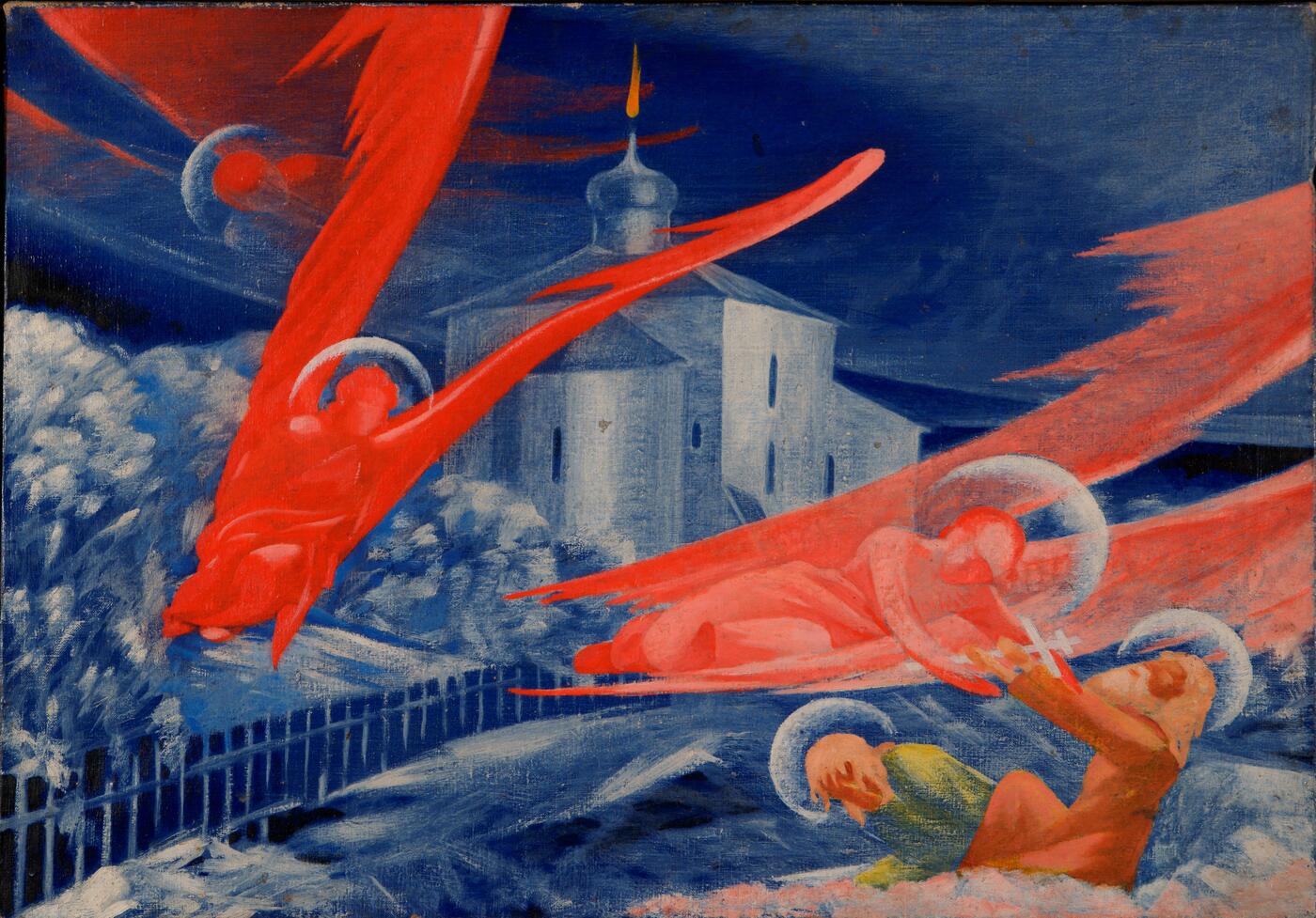27 Nov 2013 Russian Art Auctions
27 November 2013

* 12. CHUPYATOV, LEONID (1890-1941)
Angels .
Oil on canvas, 50.5 by 70.5 cm.
800,000–1,600,000 GBP
Executed c. 1922.
Provenance: Collection of Tatiana Rubinstein, widow of the renowned collector Yakov Rubinstein
(label on the reverse).
Acquired from the above by the present owner.
Exhibited: Tsvet siniy, Proun Gallery, Moscow, 13 February–10 April 2013.
Literature: Ogonek, No. 9 (3319), 23 February–2 March 1991, illustrated in a coloured insert.
Exhibition catalogue (e-version), Tsvet siniy, Moscow, Proun Gallery, 2013, illustrated.
Leonid Chupyatov’s work occupies a distinct niche of its own, not just among the most progressive and innovative painters of his time, but also among leading representatives of the school of Petrov-Vodkin, the name with which all his creative work was linked. The many stars around the great Petrov-Vodkin formed a unique aggregation of particularly talented creative personalities (the master himself loved to say that he had “not spawned amateurs”). Even in the midst of this pleiad, however, Leonid Chupyatov’s place is not only indicative, but fantastically surprising in his unprecedented individualism and understanding of the essential causes behind new art as such.
Of course, the kinship among “Vodkinites” came from their grasp of spherical compositional structure and its visionary component – a prime mover in their rejection of the static nature of classic rendition as it was tradition ally understood. They were also united, however, by their Teacher’s famous three-colour principle, which remained a strikingly distinctive feature of the whole community.
The spiritual charge emanating through the space in Chupyatov’s canvasses, however, and the all-embracing power of its unbelievable impact, elevate this astonishing artist, unlike any other, to a new level, entirely different and almost unattainable. Chupyatov is at once a philosopher and a poet. It is not only his dazzling colour and unique painting which mark out this artist’s works from the famous images of the architecturally mechanised Rodchenko epoch, but most of all for the living soul of humanity present in his work, whose sacred essence opens the way to goodness, compassion and ultimately self-sacrifice. This is what the artist’s best works are about – The Crown of Thorns (c. 1921), Pink Flamingo (1923), The Hunt (1927), Seraphim of Sarov (mid 1920s), and Protective Veil of the Mother of God over the City under Siege (1941).
The remarkable Angels continues this triumphant line of outstanding and miraculously preserved works by Leonid Chupyatov left to us from that distant, blockaded city on the Neva. Everything about the work is unusual – the subject, the composition, the colours. Of course, the subject itself can hardly be regarded as opposition to the Bolshevik regime on the part of Chupyatov: whilst spiritually inspired in his humanity, he was submissive in his humble acceptance of the hard blows fate dealt him, never failing to keep himself connected to his people and the bitter lot of his long-suffering homeland. Rather, this is a majestic ballad about saving human souls from hunger and deprivation, about their rising in their sufferings to the heights of great martyrs elevated to rank of saints. There is a symbolist quality to Chupyatov’s solemn portrayal of the tragedy he seemed to see, played out in a Russia frozen solid under hoar frost, over which angels have come down to earth like blazing scarlet phantoms with their gift of the Cross to the saved.
It is immediately apparent that despite Chupyatov’s characteristic use of Petrov-Vodkin’s three colours, he exceeds the bounds of this familiar device. The flat planes of colour are sharply contrasted and interact surprisingly in multidimensional layers. This deliberate applique effect of the figures of angels and people, and the absence of classic tonal gradations, lends an unusual liveliness to the overall composition, as if broadening its spatial scope and creating the illusion of a monumental painting.
Chupyatov’s masterpiece Angels, which the artist is presumed to have painted in 1922, may be placed without hesitation in the front rank of Russia’s finest artworks from the first quarter of the 20th century.
Notes on symbols:
* Indicates 5% Import Duty Charge applies.
Ω Indicates 20% Import Duty Charge applies.
§ Indicates Artist's Resale Right applies.
† Indicates Standard VAT scheme applies, and the rate of 20% VAT will be charged on both hammer price and premium.